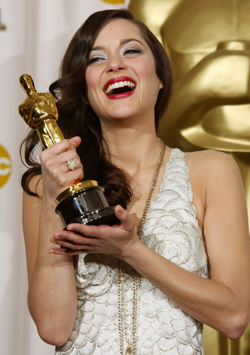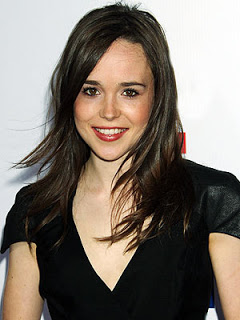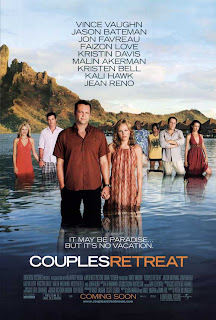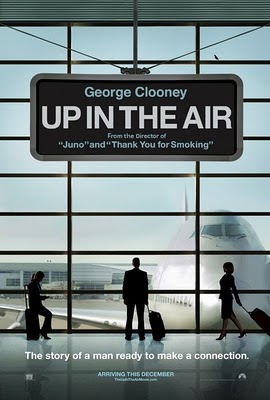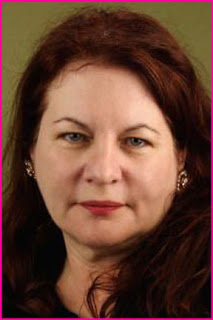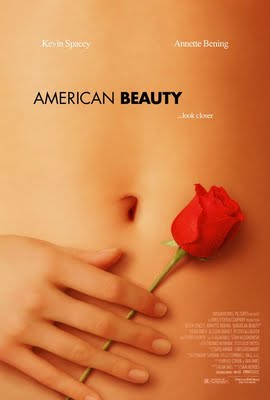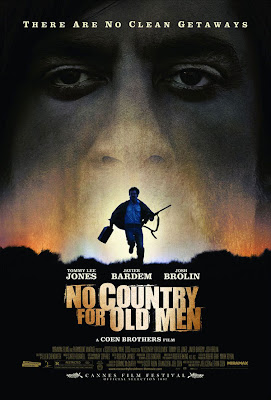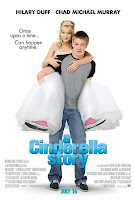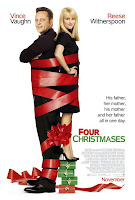Tag: Women in Hollywood
Bitch Flicks’ Weekly Picks
“The Women’s Media Center is at Sundance, where they put together a stark and riveting video to underscore the gender inequities that persist in filmmaking and in the media.”
“At the end of the movie, Olive spells out the message, that it’s nobody’s business what people do with their private lives. That’s admirable, and true. But the message means very little when the journey getting there is so icky and filled with double standards–the same double standards that the movie is supposedly criticizing, but tacitly embracing.”
“This year, there were more features, documentaries and shorts by blacks and about blacks than at any other time in the prestigious festival’s history, which began in 1978 as the Utah/U.S. Film Festival.”
“This is a cultural crisis. Women are being systematically shut out of this business. Most all the movies we see–big and small–are made by men.”
“Media is made primarily by men and for men. It is unfortunate that women consume a near equal amount of it (2009 moviegoer statistics revealed that 55% of all ticket sales are by women, who make up 52% of all moviegoers). If we don’t demand media for women, made by women and change how we’re represented in movies, we can continue to expect Hollywood and history to create male-dominated entertainment.”
“Of all the nominees they looked at, 60 percent experienced at least one divorce after being nominated for an Oscar. But the academy’s most successful women were especially likely to see their connubial bliss obliterated: a Best Actress winner’s risk of divorce was 1.68 times the risk of a nonwinning Best Actress nominee.”
“In 1999 model/waitress Jessica Lall refused to serve drinks to a rowdy man in a crowded bar, who then shot her point blank in a fit of rage. That man turned out to be the son of an influential politician, but with 300 witnesses it seemed like a straightforward case.”
Please leave links to your favorite posts this week!
Question of the Day: Do We Need a Best Female Director Category?
Since the first Academy Awards ceremony in 1929, separate acting Oscars have been presented to men and women. Women at that time had only recently won the right to vote and were still several decades away from equal rights outside the voting booth, so perhaps it was reasonable to offer them their own acting awards. But in the 21st century women contend with men for titles ranging from the American president to the American Idol. Clearly, there is no reason to still segregate acting Oscars by sex.
Quote of the Day: Sirena J. Riley
From her essay “The Black Beauty Myth,” which appears in the anthology Colonize This! (published in 2002):
As a women’s studies major in college, body image was something we discussed almost ad nauseam. It was really cathartic because we embraced the personal as political and felt safe telling our stories to our sister feminists. Whenever body image was researched and discussed as a project, however, black women were barely a footnote. Again, many white feminists had failed to step out of their reality and see beyond their own experiences to understand the different ways in which women of color experience sexism and the unattainable beauty ideals that society sets for women.
Discussions of body image that bother to include black women recognize that there are different cultural aesthetics for black and white women. Black women scholars and activists have attacked the dominance of whiteness in the media and illuminated black women’s tumultuous history with hair and skin color. The ascension of black folks into the middle class has positioned them in a unique and often difficult position, trying to hold onto cultural ties while also trying to be a part of what the white bourgeois has created as the American Dream. This not only permeates into capitalist material goals, but body image as well, creating a distinctive increase in black women’s body dissatisfaction.
White women may dominate pop culture images of women, but black women aren’t completely absent. While self-deprecating racism is still a factor in the way black women view themselves, white women give themselves too much credit when they assume that black women still want to look like them. Unfortunately, black women have their own beauty ideals to perpetually fall short of. The representation of black women in Hollywood is sparse, but among the most famous loom such beauties as Halle Berry, Jada Pinkett Smith, Nia Long, Iman and Angela Bassett. In the music scene there are the young women of Destiny’s Child, Lauryn Hill and Janet Jackson. Then, of course there is model Naomi Campbell and everyone’s favorite cover girl, Tyra Banks. Granted, these women don’t necessarily represent the waif look or heroin chic that plagues the pages of predominately white fashion and entertainment magazines, but come on. They are still a hard act to follow.
Quote of the Day: Ellen Page
I think it’s a total drag. I’ve been lucky to get interesting parts but there are still not that many out there for women. And everybody is so critical of women. If there’s a movie starring a man that tanks, then I don’t see an article about the fact that the movie starred a man and that must be why it bombed. Then a film comes out where a woman is in the lead, or a movie comes out where a bunch of girls are roller derbying, and it doesn’t make much money and you see articles about how women can’t carry a film.
I was like, “You know what? You all need to calm down.” People are so black and white about this. Because she kept the baby everybody said the film was against abortion. But if she’d had an abortion everybody would have been like, “Oh my God.” I am a feminist and I am totally pro-choice, but what’s funny is when you say that people assume that you are pro-abortion. I don’t love abortion but I want women to be able to choose and I don’t want white dudes in an office being able to make laws on things like this. I mean what are we going to do — go back to clothes hangers?
Quote of the Day: Geena Davis
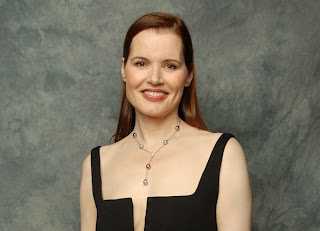 |
| Gender in Media activist and actress Geena Davis |
Perhaps best known for her award-winning roles on television and in film, Geena Davis is the founder of the Geena Davis Institute on Gender in Media. According to the website
Five years ago, while watching children’s television programs and videos with her then 2-year old daughter, Academy Award winner Geena Davis noticed a remarkable imbalance in the ratio of male to female characters. From that small starting point, Davis went on to raise funds for the largest research project ever undertaken on gender in children’s entertainment (resulting in 4 discrete studies, including one on children’s television).The research showed that in the top-grossing G-rated films from 1990-2005, there were three male characters for every one female – a statistic that did not improve over time.
The concern was clear: What message does this send to young children?
We really learn our value in society by seeing ourselves reflected in the culture–kids more so than anyone. I mean, as they’re learning what their role in society is and what’s their place and value, they’re exposed to massive amounts of media, and the message that boys and girls are getting currently is that girls are not as valuable as boys, and that women are not as important as men.
Kudos to Geena Davis for tackling this important problem. Check out her website, and watch a short interview about her project below.
Guest Post: Holy Hypocrisy: Couples Retreat
 |
| Actor Faizon Love as Shane |
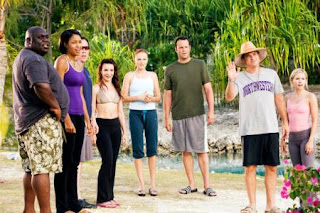 |
| The group shot |
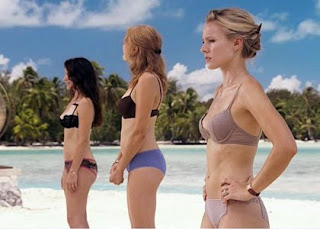 |
| Davis, Akerman, and Bell |
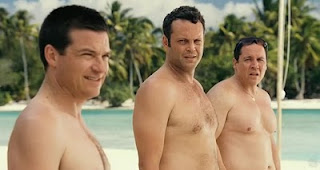 |
| Bateman, Vaughn, and Favreau |
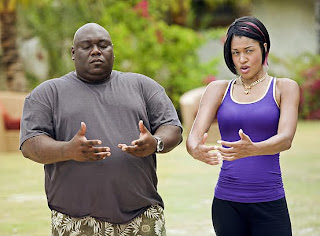 |
| Love and Hawk |
 |
| Kristin Davis in lingerie |
Molly McCaffrey teaches English and creative writing at Western Kentucky University. Her blog, I Will Not Diet, chronicles her effort to lose weight without unhealthy dieting and encourages readers to reject the notion that curvy women are not attractive. She has been nominated for a 2009 Pushcart Prize, and her work has appeared in numerous magazines and books. She is also co-editor of the newly released Commutability: Stories about the Journey from Here to There.
Golden Globe Nominated Films: In Posters
I’m excited for this year’s film nominees! Julie & Julia stars two awesome actresses: Meryl Streep and Amy Adams. Streep also stars in It’s Complicated, which was written and directed by Nancy Meyers. Nine (while, admittedly, might potentially sexually exploit the actresses) still boasts an all-star cast of women, including Oscar winners Nicole Kidman, Judi Dench, Marion Cotillard, and Penelope Cruz. Kathryn Bigelow has gotten all kinds of press for directing The Hurt Locker, and, while Up in the Air gives Clooney top-billing, I have no doubt that Vera Farmiga and Anna Kendrick will wake up to Oscar nominations in February for their wonderful performances. And Precious! What a great year for the many women involved with this film. Kudos to the Golden Globes for recognizing so many women in film this year!
Independent Spirit Award Nominations: A Closer Look
I had a discussion with my husband after the film, and pointed out that most women perceive themselves as the protagonists of their own lives, not as an avid audience for men as they play out their stories. My experience throughout my life when watching movies like this has been to desperately try to find a place for myself among the male characters …
… The sad thing about this film is that I could have really enjoyed it otherwise. As I was watching it I wondered why I was feeling so fatigued, and I realized it was because it was yet another time that I was expected to happily stand in the sidelines and watch boys have lots of fun. That’s such a bummer to me nowadays that I can’t even pretend to be enthused anymore.
Male-Driven Film Nominees
Humpday: Two guys take their bromance to another level when they participate in an art film project.
Big Fan: Paul Aufiero, a hardcore New York Giants football fan, struggles to deal with the consequences when he is beaten up by his favorite player.
A Serious Man: A black comedy set in 1967 and centered on Larry Gopnik, a Midwestern professor who watches his life unravel when his wife prepares to leave him because his inept brother won’t move out of the house.
Two Lovers: A Brooklyn-set romantic drama about a bachelor torn between the family friend his parents wish he would marry and his beautiful but volatile new neighbor.
A Single Man: A story that centers on an English professor who, after the sudden death of his partner tries to go about his typical day in Los Angeles.
The Messenger: An American soldier struggles with an ethical dilemma when he becomes involved with a widow of a fallen officer.
Easier With Practice: In an effort to promote his unpublished novel, Davy Mitchell sets out on a road trip with his younger brother.
Crazy Heart: Bad Blake is a broken-down, hard-living country music singer who’s had way too many marriages, far too many years on the road and one too many drinks way too many times. And yet, Bad can’t help but reach for salvation with the help of Jean, a journalist who discovers the real man behind the musician.
Anvil: At 14, best friends Robb Reiner and Lips made a pact to rock together forever. Their band, Anvil, hailed as the “demi-gods of Canadian metal,” influenced a musical generation that includes Metallica, Slayer, and Anthrax, despite never hitting the big time.
More Than a Game: This documentary follows NBA superstar LeBron James and four of his talented teammates through the trials and tribulations of high school basketball in Ohio and James’ journey to fame.
Un Prophete: A young Arab man is sent to a French prison where he becomes a mafia kingpin. (French/Arabic/Corsican)
Adventureland: A comedy set in the summer of 1987 and centered around a recent college grad who takes a nowhere job at his local amusement park, only to find it’s the perfect course to get him prepared for the real world.
The Vicious Kind: A man tries to warn his brother away from the new girlfriend he brings home during Thanksgiving, but ends up becoming infatuated with her in the process.
Cold Souls: Paul Giamatti stars as himself, agonizing over his interpretation of “Uncle Vanya.” Paralyzed by anxiety, he stumbles upon a solution via a New Yorker article about a high-tech company promising to alleviate suffering by extracting souls.
Bad Lieutenant: While investigating a young nun’s rape, a corrupt New York City police detective, with a serious drug and gambling addiction, tries to change his ways and find forgiveness.
Female-Driven Film Nominees
Sin Nombre: Honduran teenager Sayra reunites with her father, an opportunity for her to potentially realize her dream of a life in the U.S. Moving to Mexico is the first step in a fateful journey of unexpected events. (Spanish)
Precious: In Harlem, an overweight, illiterate teen who is pregnant with her second child is invited to enroll in an alternative school in hopes that her life can head in a new direction.
Amreeka: A drama centered on an immigrant single mother and her teenage son in small town Illinois. (English/Arabic)
Everlasting Moments: In a time of social change and unrest, war and poverty, a young working class woman, Maria, wins a camera in a lottery. The decision to keep it alters her whole life. (Swedish/Finnish)
The Maid: A drama centered on a maid trying to hold on to her position after having served a family for 23 years. (Spanish)
Mother: A woman is forced to investigate a murder after her son is wrongfully accused of the crime. (Korean)
An Education: A coming-of-age story about a teenage girl in 1960s suburban London, and how her life changes with the arrival of a playboy nearly twice her age. (English, from the UK)
Ensemble-Driven Film Nominees
The Last Station: The Countess Sofya, wife and muse to Leo Tolstoy, uses every trick of seduction on her husband’s loyal disciple, whom she believes was the person responsible for Tolstoy signing a new will that leaves his work and property to the Russian people.
500 Days of Summer: An offbeat romantic comedy about a woman who doesn’t believe true love exists, and the young man who falls for her.
Paranormal Activity: After moving into a suburban home, a couple becomes increasingly disturbed by a nightly demonic presence.
Which Way Home: Which Way Home is a feature documentary film that follows unaccompanied child migrants, on their journey through Mexico, as they try to reach the United States. (English/Spanish)
October Country: October Country is a beautifully filmed portrait of an American family struggling for stability while haunted by the ghosts of war, teen pregnancy, foster care and child abuse.
Food, Inc.: An unflattering look inside America’s corporate controlled food industry.
Director Spotlight: Allison Anders
The hardships encountered and overcome by director Allison Anders are often reflected in the grittiness and strength of her female characters, a quality that lends her stories a tough but refreshing honesty. Anders cares about her characters, but she refuses to give them falsely happy endings and this refusal distinguishes her from other directors of so-called women’s films who make their movies into little more than celluloid Hallmark cards. Anders’ approach to this kind of storytelling has given her distinction in the film industry and she continues to make films that challenge conventional attitudes toward both women and films about women.
Born November 16, 1954, in Ashland, KY, Anders had an upbringing that was nothing if not traumatic. At the age of five, she, her mother, and four sisters were abandoned by her father, and were forced into an unstable, itinerant lifestyle. At the age of 12, Anders was raped and then endured abuse from her stepfather, who at one point threatened her with a gun. Anders suffered a mental breakdown when she was 15 years old, after her mother took her daughters to Los Angeles to escape further abuse. Following time in psychiatric wards, later in foster homes and jail, Anders ventured back to Kentucky, then moved to London with the man who would father her daughter.
 Border Radio: 1987
Border Radio: 1987
Independent Film Quarterly critic Todd Konrad summarizes the film as follows:
Chris D plays Jeff, an underground singer-songwriter who along with his bandmate Dean (played by Doe) and hanger-on Chris (played by Chris Spencer), rob a local rock club of both money and drugs. In order to avoid retribution from the club owner and his henchmen, Jeff escapes across the border to Mexico where he hides out to let the heat die down. Left in the lurch is Jeff’s wife Luanna and their young daughter Devon (played respectively by Anders’ real life sister and daughter, Luanna and Devon Anders). In order to keep things together, Luanna, a local rock journalist, is left to play detective in order to figure out exactly what happened to send Jeff away. The hope being that she will find a way to bring her man back from across the border and fix whatever problems he may have incurred in doing so.
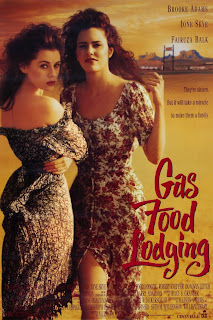
Gas Food Lodging: 1992
Starring Brooke Adams, Ione Skye, Fairuza Balk, and James Brolin
Imagine “The Last Picture Show” shot in color and shaped by a rueful feminine perspective, in a place where women are hopelessly anchored while the men drift through like tumbleweed. The becalmed town of Laramie, N.M., is the setting in which Nora (Brooke Adams), a hard-working waitress with a knowing, generous grin, has tried to bring up her two unruly daughters.

Starring Angel Aviles, Seidy Lopez, Devine, Monica Lutton, and Christina Solis
In “Mi Vida Loca My Crazy Life,” Allison Anders tries what few directors would have had the interest or intelligence to think of. She looks beyond the surface of the lives of Hispanic girl gangs and attempts to create a deeper portrait of young women in the Echo Park section of Los Angeles. They use gang names, like Sad Girl, Mousie and Whisper. And though violence is part of their lives, they are likely to be teen-age mothers struggling to get by.

Starring Sammi Davis, Valeria Golino, Madonna, Ione Skye, and Lily Taylor
The story—what little there is—revolves around a witches’ coven trying to resurrect the spirit of a stripper. All the ingredients (mother’s milk, virgin’s blood, sweat of five men’s thighs, and a year’s tears) are ready except for a sperm sample. Since witch Eva (Ione Skye) failed in her assignment to bring this vital component of the mixture, she is charged with seducing Ted and getting what she needs from him.
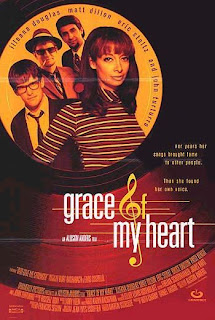
Starring Illeana Douglas, Sissy Boyd, Christina Pickles, and Jill Sobule
Loosely inspired by the life of Carole King, this is a light, feminist take on 15 years of pop: hits and Ms, if you will. It begins with a bright, peppy tone, pastiching the nascent rock’n’roll scene with an affectionate smile and perfect pitch—the Larry Klein-produced soundtrack is spot on. But it’s not all kitsch nostalgia: the period coincides with great social changes, particularly regarding the role of women, a recurrent Anders theme. Sharp cameos include Patsy Kensit’s rival songwriter and Bridget Fonda’s teen songbird with a secret love.

Starring Jade Gordon, John Taylor, Michael Des Barres, and Martin Kemp
It isn’t easy growing old in the land of youth and beauty. It’s even harder if you’re a rock-and-roller who hasn’t had a hit in decades, or a sexy leading lady now being offered parts as Christina Ricci’s mother. “Sugar Town,” an agreeably scruffy L.A. satire co-written and directed by Allison Anders and Kurt Voss, is filled with sharp, funny snapshots of the hustlers, has-beens, recovering junkies and Topanga Canyon earth mothers on the fringes of the Hollywood music biz.
Ten Years of Oscar-Winning Films: In Posters

***
Gladiator: 2001

***
A Beautiful Mind: 2002

***
Chicago: 2003

***
The Lord of the Rings: The Return of the King: 2004
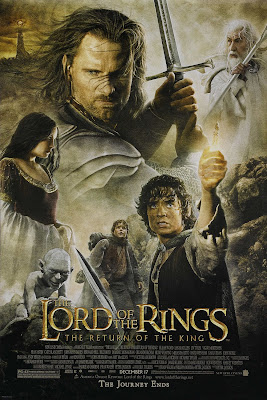
*** Million Dollar Baby: 2005

***
Crash: 2006
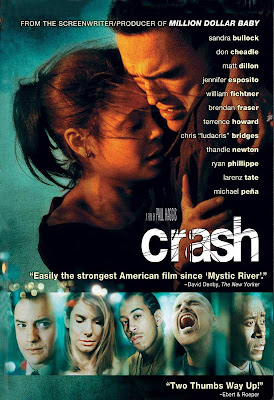
***
The Departed: 2007
What do these films have in common?
American Beauty: A man narrates the film, has a midlife crisis, and attempts to seduce and/or rape a potentially underage high school student.
Gladiator: A man in captivity avenges the murder of his wife and son by murdering their murderer.
A Beautiful Mind: A man at the height of his genius suffers from schizophrenia.
Chicago: A singing and dancing man attempts to save singing and dancing female inmates from death row.
The Lord of the Rings: Men go on a quest.
Million Dollar Baby: A man narrates the film, telling the story of his friend’s attempt to train and manage a determined female boxer.
Crash: A cast of characters—male and female—illustrates our society’s inability to distinguish between racism and prejudice.
The Departed: Men violently kill one another.
No Country For Old Men: A hired hitman goes on a killing spree with a captive bolt pistol.
Slumdog Millionaire: A man participates in a televised game-show, thinking it will help him find his long-lost love.
I’m interested to see how the 2010 Academy Awards Ceremony will choose to honor this year’s films, especially now that they’ve bumped up the number of Best Picture nominees to ten instead of five. With the amount of women-centered and/or directed films this year—Julie & Julia, Precious: Based on the Novel Push by Sapphire, Bright Star, Amelia, and The Hurt Locker, to name a few—I hope women will feel some of the Academy love. Don’t forget to check back in February for analysis of the ten Best Picture nominees!
Movie Posters: Are You Ready for Death/Love/Prison?

1) your man is going to carry you away from your god-awful once man-less life
2) you’re going to ride the shit out of your man while … possibly selling your body?
3) boobs
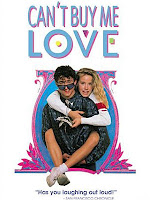
 First of all, the women of Blind Dating clearly represent all women that a man might potentially have the pleasure of one day blind dating. There are no female stereotypes in this poster at all whatsoever. And my god isn’t he so completely gorgeous and worthy of all this hot-girl worship? This poster doesn’t remind me at all whatsoever of films with average-joe male leads who somehow end up in a clusterfuck of girl-stalk. That would, in fact, be a ridiculous concept in general, one that would definitely never hold up as an actual movie plot. And Four Christmases, thanks for the Christmas present illustration. I’m not quite sure which obvious rom-com bullshit I’m supposed to take from that—their relationship is a gift? they’re in it together? ohmigod don’t leave me?—but thanks. Seriously, thanks.
First of all, the women of Blind Dating clearly represent all women that a man might potentially have the pleasure of one day blind dating. There are no female stereotypes in this poster at all whatsoever. And my god isn’t he so completely gorgeous and worthy of all this hot-girl worship? This poster doesn’t remind me at all whatsoever of films with average-joe male leads who somehow end up in a clusterfuck of girl-stalk. That would, in fact, be a ridiculous concept in general, one that would definitely never hold up as an actual movie plot. And Four Christmases, thanks for the Christmas present illustration. I’m not quite sure which obvious rom-com bullshit I’m supposed to take from that—their relationship is a gift? they’re in it together? ohmigod don’t leave me?—but thanks. Seriously, thanks.

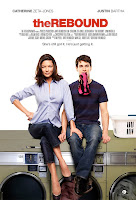
See what women do, boys? Emasculate. Dominate. Take away your ability to, you know, speak. And don’t they look like they’re having a blast doing it?
